 In this short post I challenge the Reader to answer 10 Quiz questions on Quality Assurance.
In this short post I challenge the Reader to answer 10 Quiz questions on Quality Assurance.
Though the Quality Assurance function is most commonly sited with the Contact Center, its use and understanding can be broadened across any Customer Service environment including hospitals, universities, government offices and more.
Those of you that I’ve worked with in classes or talks around the world know how much I like to give out these kinds of Quizzes.
And this Quiz is free, doesn’t involve any registration and your name won’t be added to any list. We do this just to help & inspire!
The 10 Quiz Questions on Quality Assurance
Here are the 10 Quiz Questions on Quality Assurance.
Reach each question carefully and then select the right answer which is either a, b, c or d.
Yes – there is only one correct answer for each question.
1. Which of the following is the BEST example of a Compliance Standard?
a. Greeting
b. Tone of Voice
c. Rapport Building
d. Empathy
2. The 3 most common inputs used in Performance Standard design are:
a. Customer Expectations, Profit Forecasts, Manpower Requirements
b. Regulatory Requirements, Customer Expectations, Market Share
c. Customer Expectations, Regulatory Requirements, Headcount Requirements
d. Organizational Vision, Customer Expectations, Regulatory Requirements
3. The best description of a Service Delivery Vision is:
a. A statement that lists out all the Compliance Standards to follow
b. It is usually the same as the Organizational Vision
c. It describes the kind of service we will deliver around here
d. It is most useful for Contact Center Agents
4. If you rely too much on Compliance Standards your Frontline Agents will sound:
a. Friendly
b. Robotic
c. Warm
d. Compliant
5. Which of the following statements is/are TRUE?
I. All Performance Standards on an “Interaction Audit” form should have equal weight
II. First Contact Resolution can be difficult to calculate
III. Customer Expectations are the main source for selecting Performance Standards
IV. A high First Contact Resolution rate is always good
a. II only
b. II and IV only
c. II, III and IV only
d. I, II, III and IV
6. Which of the following are included in the formal documentation of a Performance Standard?
I. The purpose or business reason for the standard
II. The scoring logic for the standard
III. Examples of how the standard is to be used
IV. A formal definition of the standard
a. I & II
b. I, II and III
c. I, II, III & IV
d. None of the above
7. Which of the following statements is/are FALSE?
I. Normally Quality Assurance does all the interaction monitoring & scoring
II. It’s best to let Quality Assurance do the Agent coaching
III. Team Leaders should focus mostly on productivity
IV. It’s ok to schedule one full hour of coaching per week per Agent
a. II only
b. II and IV only
c. II, III and IV only
d. I, II, III and IV
8. Which of the following statements is/are TRUE?
I. All Calibration sessions should incorporate a Scorecard
II. Calibration sessions should be held once a month
III. In Calibration make sure everyone agrees on every Performance Standard on an interaction before moving on
IV. It’s a good idea to include Agents in the Calibration sessions
a. II only
b. II and IV only
c. II, III and IV only
d. None of the above
9. If you had only one way to achieve behavioural change through coaching which one would be the BEST?
a. Give detailed graphs showing the performance of all Performance Standards over a 3 month period
b. Ensure that Agents are coached without a scorecard at least one time per week
c. Ensure that Agents are coached with a scorecard at least one time per week
d. Allow Agents to coach themselves
10. When it comes to monitoring which one of the following statements is TRUE?
a. Side by side monitoring doesn’t work well because Agents can ‘fake it’
b. Mystery Shopper is one of the formal methods of monitoring
c. Mystery Shopper research is best done ‘in-house’ rather than outsourced to a research company
d. It’s always best to let the Agent self evaluate first
Would you like to know how you did?
If you’d like to know if your answers are correct we’re happy to help.
We’ve intentionally gone ‘low-tech’ here. Once you’ve answered all (10) questions just drop an email to me at [email protected]
Let me know the question # and the answer that you chose (either a,b,c or d).
You can use the following format in your email to me:
- a
- d
- c
- c (and so on for all 10 Quiz Questions)
It helps also to tell me which Quiz you took. This Quiz is for Quality Assurance.
I always do my best to answer quickly and let you know which ones you got right. And for the ones you may have gotten wrong I will let you know what the right answer is.
Thank you for reading and giving the Quiz a go!
 Daniel
Daniel




 That happens when the author of the article positions the company they’re describing in one of two ways:
That happens when the author of the article positions the company they’re describing in one of two ways: With her usual pragmatism she told me –
With her usual pragmatism she told me –


 I think that the biggest benefit to earning a professional credential is the journey you take and the people you meet along that journey.
I think that the biggest benefit to earning a professional credential is the journey you take and the people you meet along that journey. Leadership is the combination of skills, knowledge and experience that enable a person to inspire others to accomplish a shared goal.
Leadership is the combination of skills, knowledge and experience that enable a person to inspire others to accomplish a shared goal. A big part of Customer Experience involves working across functional boundaries. If you’re in a formalized CX function that’s pretty clear already.
A big part of Customer Experience involves working across functional boundaries. If you’re in a formalized CX function that’s pretty clear already. Ask not what your country can do for you, but what you can do for your country.
Ask not what your country can do for you, but what you can do for your country.


 Formal living rooms may sound old fashioned – but they’re still around.
Formal living rooms may sound old fashioned – but they’re still around. For a University Contact Center, the Agents were instructed to immediately redirect the Caller to the university website if it turned out that the information was available there.
For a University Contact Center, the Agents were instructed to immediately redirect the Caller to the university website if it turned out that the information was available there.  I bet you can imagine what those Agents sounded like when we listened to the calls. Yup that’s right.
I bet you can imagine what those Agents sounded like when we listened to the calls. Yup that’s right.

 In a Keynote Speech, the scenario is obviously different. You have perhaps 20 minutes – 40 minutes with hundreds of folks in attendance.
In a Keynote Speech, the scenario is obviously different. You have perhaps 20 minutes – 40 minutes with hundreds of folks in attendance. While it’s true that Customer Service is a subset of Customer Experience – it’s an important subset for some and a critical subset for others.
While it’s true that Customer Service is a subset of Customer Experience – it’s an important subset for some and a critical subset for others.










